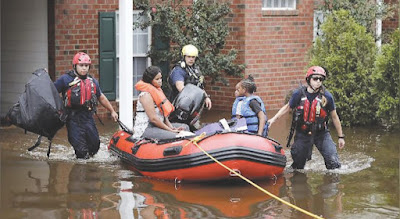 |
| Rescue personnel evacuate residents as flooding continues in the aftermath of Hurricane Florence in Spring Lake, N.C., Monday, Sept. 17, 2018. AP Photo/David Goldman |
Topics: Climate Change, Global Warming, Politics, Research
We're not over it, not by a long shot. This will, even to the callous capitalists, be un-affordable and unsustainable.
As Hurricane Florence’s wrath along the Carolina coast concludes, things for thousands of North and South Carolina families will never be the same. Heavy downpours from the Category 4 storm, which was downgraded to a Category 2 when it hit landfall, brought flash flooding from the coastal plain last Thursday all the way to the Triad by late Sunday night. Winds in some parts of Guilford County reached upwards of 30 mph, with Guilford County receiving a total of up to 24 inches of rain.
Although Florence had been downgraded to a Tropical Depression by the time it reached Guilford County, the area experienced flash flooding, while other parts of the state experienced extreme flooding that will likely last several weeks. Duke Energy reported 1.4 million total power outages in the Carolinas. There have been at least 37 storm-related deaths reported – 27 in North Carolina, eight in South Carolina and two in Virginia. Preliminary numbers from government officials estimate the storm left behind $2.5 billion in damages to the state of North Carolina. The storm also kept Eastern North Carolina synagogues closed on September 19, the Jewish holy day of Yom Kippur.
In Greensboro, a section of Lake Brandt Road is still closed while crews repair a sinkhole that formed in the pavement under a bridge due to heavy rain flow. City officials also reported that 63,000 gallons of untreated wastewater in Greensboro leaked from Buffalo Creek and the Cape Fear River basin for four hours before it was detected. [1]
*****
When Hurricane Florence thundered ashore, it came crashing down on Duke Energy’s coal ash disposal site and cajoled loose some 2,000 cubic yards of the mucky material. Duke, which is closing all of its coal ash sites by 2029, has been through this before. What has the industry learned?
Coal ash is disposed of either as a liquid that goes into large surface impoundments or as a solid that is placed into landfills. But now the industry is in the process of converting it to dry ash and burying it in places with liners while also monitoring the ground water.
“Once the damage is assessed,” says the North Carolina Department of Environmental Quality, “DEQ will determine the best path forward and hold the utility accountable for implementing the solution that ensures the protection of public health and the environment.” [2]
*****
Millions of chickens have died and waste from pigs and coal ash has leaked into floodwaters in North Carolina as authorities work to control environmental threats and stop the spread of any contamination.
But continued high water is keeping state and federal officials from knowing the full extent of the problem.
Officials are most concerned that the coal-burning byproducts, animal waste, and even untreated human sewage in floodwaters could contaminate sources of drinking water. The Environmental Protection Agency said Monday that at least 23 public and private drinking water systems in North Carolina were not supplying water and that 21 others were operating with restrictions like a boil water advisory.
Reggie Cheatham, director of the EPA's Office of Emergency Management, said Monday that some sewage has been released into the floodwaters through sewer system manholes and, in one case, a power failure at a water treatment plant. Cheatham told reporters some of the untreated sewage had been released into the Neuse and Cape Fear rivers. [3]
1. Hurricane Florence Aftermath, Yasmine Regester, Carolina Peacemaker online
2. Hurricane Florence Brings The Issue Of Coal Ash Back To The Surface, Ken Silverstein, Forbes
3. Concern continues about overflowed animal waste pits, coal ash in Florence flooding, Stephanie Ebbs, ABC News
Comments